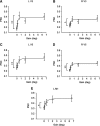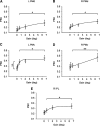Selective regions of the visuomotor system are related to gain-induced changes in force error
- PMID: 20181732
- PMCID: PMC2853269
- DOI: 10.1152/jn.00920.2009
Selective regions of the visuomotor system are related to gain-induced changes in force error
Abstract
When humans perform movements and receive on-line visual feedback about their performance, the spatial qualities of the visual information alter performance. The spatial qualities of visual information can be altered via the manipulation of visual gain and changes in visual gain lead to changes in force error. The current study used functional magnetic resonance imaging during a steady-state precision grip force task to examine how cortical and subcortical brain activity can change with visual gain induced changes in force error. Small increases in visual gain < 1° were associated with a substantial reduction in force error and a small increase in the spatial amplitude of visual feedback. These behavioral effects corresponded with an increase in activation bilaterally in V3 and V5 and in left primary motor cortex and left ventral premotor cortex. Large increases in visual gain > 1° were associated with a small change in force error and a large change in the spatial amplitude of visual feedback. These behavioral effects corresponded with increased activity bilaterally in dorsal and ventral premotor areas and right inferior parietal lobule. Finally, activity in the left and right lobule VI of the cerebellum and left and right putamen did not change with increases in visual gain. Together, these findings demonstrate that the visuomotor system does not respond uniformly to changes in the gain of visual feedback. Instead, specific regions of the visuomotor system selectively change in activity related to large changes in force error and large changes in the spatial amplitude of visual feedback.
Figures





References
-
- Caminiti R, Ferraina S, Johnson PB. The sources of visual information to the primate frontal lobe: a novel role for the superior parietal lobule. Cereb Cortex 6: 319–328, 1996 - PubMed
-
- Carey JR, Greer KR, Grunewald TK, Steele JL, Wiemiller JW, Bhatt E, Nagpal A, Lungu O, Auerbach EJ. Primary motor area activation during precision-demanding versus simple finger movement. Neurorehabil Neural Repair 20: 361–370, 2006 - PubMed
-
- Crowe DA, Chafee MV, Averbeck BB, Georgopoulos AP. Participation of primary motor cortical neurons in a distributed network during maze solution: representation of spatial parameters and time-course comparison with parietal area 7a. Exp Brain Res 158: 28–34, 2004 - PubMed
-
- Culham JC, Brandt SA, Cavanagh P, Kanwisher NG, Dale AM, Tootell RB. Cortical fMRI activation produced by attentive tracking of moving targets. J Neurophysiol 80: 2657–2670, 1998 - PubMed
Publication types
MeSH terms
Grants and funding
LinkOut - more resources
Full Text Sources

